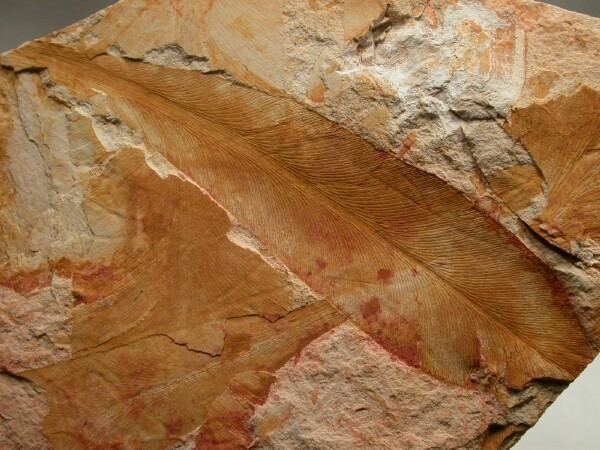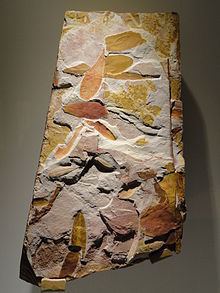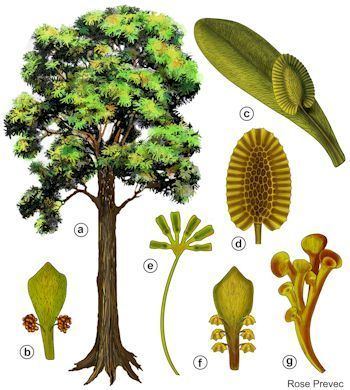Scientific name Glossopteris | ||
 | ||
Similar Mesosaurus, Lystrosaurus, Pteridospermatophyta, Cynognathus, Gangamopteris | ||
Glossopteris fossil
Glossopteris (Ancient Greek: γλώσσα glossa, meaning "tongue", because the leaves were tongue-shaped) is the largest and best-known genus of the extinct order of seed ferns known as Glossopteridales (also known as Arberiales or Ottokariales). The genus Glossopteris refers only to leaves, within a framework of form genera used in paleobotany. For likely reproductive organs see Glossopteridaceae, and these are important because they indicate biological identity of these plants that were critical for recognizing former connections between the varied fragments of Gondwana: South America, Africa, India, Australia, New Zealand, and Antarctica.
Contents
- Glossopteris fossil
- Scott s glossopteris specimen natural history museum
- History
- Taxonomy
- Description
- Paleoecology
- Outcrops in Brazil
- References

Scott s glossopteris specimen natural history museum
History

The Glossopteridales arose in the Southern Hemisphere around the beginning of the Permian Period (298.9 million years ago), but became extinct during the end-Permian mass extinction. Their distribution across several, now detached, landmasses led Eduard Suess, amongst others, to propose that the southern continents were once amalgamated into a single supercontinent—Pangea. These plants went on to become the dominant elements of the southern flora through the rest of the Permian but disappeared in almost all places at the end of the Permian (252.17 million years ago). The only convincing Triassic records are very earliest Triassic leaves from Nidpur, India, but even these records are somewhat questionable owing to faulting and complex juxtapositioning of Permian and Triassic strata at Nidpur. Although most modern palaeobotany textbooks cite the continuation of glossopterids into later parts of the Triassic and, in some cases into the Jurassic, these ranges are erroneous and are based on misidentification of morphologically similar leaves such as Gontriglossa, Sagenopteris, or Mexiglossa. Glossopterids were, thus, one of the major casualties of the end-Permian mass extinction event.

More than 70 fossil species of this genus have been recognized in India alone, with additional species from South America, Australia, Africa, Madagascar and Antarctica. Essentially, Glossopteris was restricted to the middle- and high-latitude parts of Gondwana during the Permian and was an important contributor to the vast Permian coal deposits of the Southern Hemisphere continents. Most northern parts of South America and Africa lack Glossopteris and its associated organs. However, in recent years a few disparate localities in Morocco, Oman, Anatolia, the western part of the island of New Guinea, Thailand and Laos have yielded fossils that are of possible glossopterid affinity. These peri-gondwanan records commonly occur together with Cathaysian or Euramerican plant species—the assemblages representing a zone of mixing between the strongly provincial floras of the Permian. Apart from those in India and the peri-gondwanan localities, a few other fossils from the Northern Hemisphere have been assigned to this group, but these are not identified with great certainty. For example, specimens assigned to Glossopteris from the far east of Russia in the 1960s are more likely to be misdentifications of other gymnosperms such as Pursongia. Confident assignment of fossil leaves to Glossopteris normally requires their co-preservation with the distinctive segmented roots of this group (called Vertebraria) or with the distinctive fertile organs.
Taxonomy

Long considered a fern after its discovery in the 1820s, it was later assigned to the gymnosperms. The genus is placed in the division Pteridospermatophyta. In reality, many of the plant groups included within this division are only distantly related to one another. Glossopterids' relationships with other groups remain obscure. Most recent phylogenetic analyses favour placement of glossopterids as sister to a large group including Corystospermales, Caytoniales, Bennettitales, Pentoxylales, Gnetales (in some analyses), and angiosperms. A few analyses favour alternative links with Ginkgoales, Cordaitales and Pinales.
Glossopteris should strictly be used to refer to the distinctive spathulate fossil leaves with reticulate venation, however, the term has also been used to refer to the parent plant as a whole.
Description
Glossopteris was a woody, seed-bearing shrub or tree, some apparently reaching 30 metres (98 ft) tall. They had a softwood interior that resembles conifers of the family Araucariaceae. Seeds were borne on one side of variably branched or fused structures, and microsporangia containing pollen were borne in clusters at the tips of slender filaments. Both the seed- and pollen-bearing organs were partially fused (adnate) to the leaves, or, in some cases, possibly positioned in the axils of leaves. The homologies of the flattened seed-bearing structures have remained particularly controversial with some arguing that the fertile organs represent megasporophylls (fertile leaves) whereas others have interpreted the structures as flattened, seed-bearing, axillary axes (cladodes). It is unclear whether glossopterids were monoecious or dioecious.
Paleoecology
They are interpreted to have grown in very wet soil conditions, similar to the modern Bald Cypress. The leaves ranged from about 2 cm to over 30 cm in length.
The profile of glossopterid trees is largely speculative as complete trees have not been preserved. However, based on analogies with modern high-latitude plants Glossopteris trees probably tapered upwards like a Christmas tree and were relatively widely spaced to take advantage of the low-angle sunlight at high latitudes. Instead of needles, they had large, broad lance- or tongue-shaped leaves that fell to the ground at the end of summer. The fossil leaves are commonly found as dense accumulations representing autumnal leaf banks. The broad fossilized growth rings in many Glossopteris woods reveal that the plants experienced strong growth spurts each spring-summer but underwent abrupt cessation of growth before each following winter.
Glossopteris leaves are morphologically simple so there are few characters that can be used to differentiate species. Consequently, many past researchers have considered the Permian Glossopteris flora to be rather homogeneous with the same species distributed throughout the Southern Hemisphere. However, more recent studies of the more morphologically diverse fertile organs have shown that taxa had more restricted regional distributions and several intra-gondwanan floristic provinces are recognizable. Seeds, much too large to be wind-borne, could not have blown across thousands of miles of open sea, nor is it likely they have floated across vast oceans. Observations such as these led the Austrian geologist Eduard Suess to deduce that there had once been a land bridge between these areas. He named this large land mass Gondwanaland (named after the district in India where the plant Glossopteris was found). These same observations would also lend support to Alfred Wegener'S Continental drift theory.
The first Antarctic specimens of Glossopteris were discovered by members of Robert Scott's doomed Terra Nova Expedition. The expedition members abandoned much of their gear in an effort to reduce their load, but kept 35 pounds of Glossopteris fossils; these were found alongside their bodies.
Outcrops in Brazil
The first investigation of a Glossopteris flora associated with coal seams within a paleogeographic and palaeoclimatic context, in the Paraná Basin, southern Brazil, was that by geologist Israel Charles White in 1908. This allowed correlation between Gondwanan coal deposits in southern Brazil and those documented in South Africa, Australia, India and Antarctica, and showed that this flora flourished in latitudes near the south pole.
In Rio Grande do Sul, Glossopteris leaves were found in paleorrota at Mina Faxinal, in Arroio dos Ratos at Mina Morro do PapaléO in Mariana Pimentel and Quitéria in Pantano Grande. Various species were recovered from the Rio Bonito Formation at these sites including G. angustifolia, G. brasiliensis, G. browniana, G. communis, G. indica and G. occidentalis.
